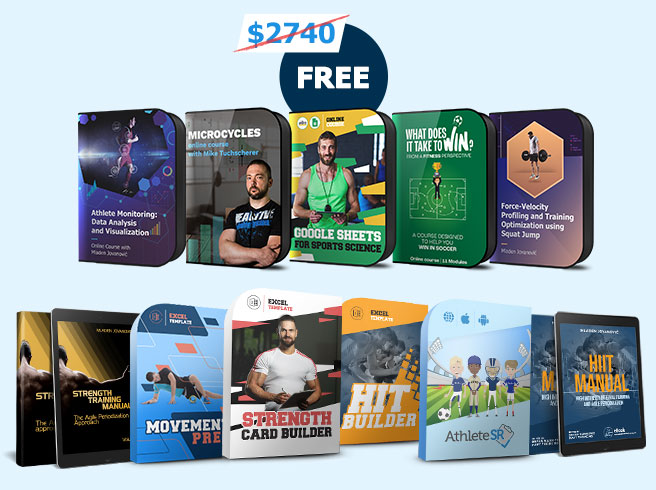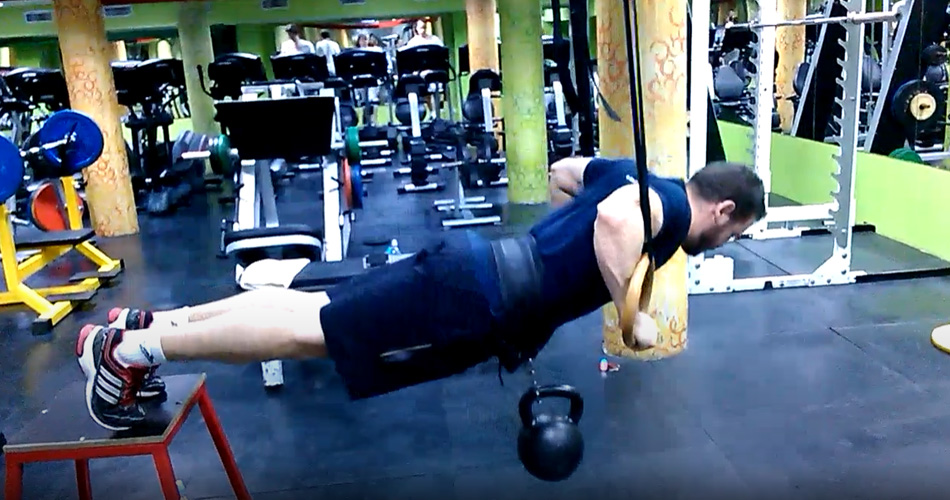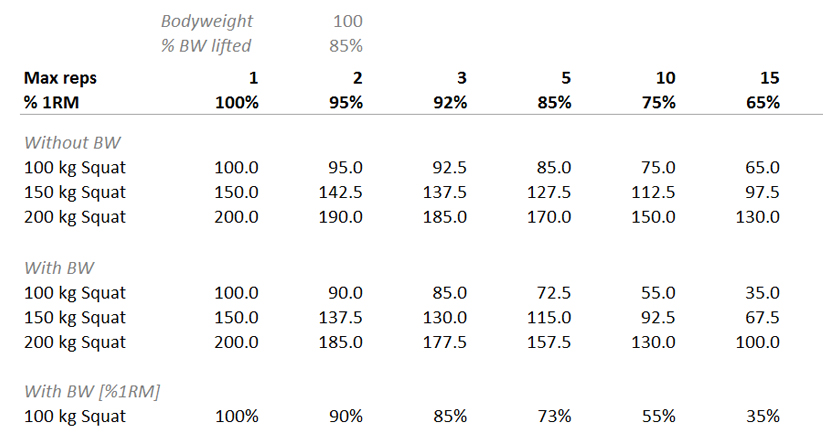Planning the Strength Training (Part 3)
Planning the Strength Training Article Series:
- Planning the Strength Training – Part 1
- Planning the Strength Training – Part 2
- Planning the Strength Training – Part 3
- Planning the Strength Training – Part 4
THE NOVICE LIFTER
No matter what sport athlete comes from, if he starts doing serious (not counting wellness experience here) strength training for the first time, he is novice. Be it experienced soccer player, basketball player, Olympic weightlifting beginner, powerlifting beginner or beginner bodybuilder he is usually weak as a kitten and skinny or sometimes fat (although I will not go into nutrition counseling here – go to John Berardi and Lyle McDonald for this).
The main characteristics of novice lifter is that he needs very simple planning and his strength grows up rapidly. Mark Rippetoe provides excellent explanation of all phases of the lifter in Practical Programming book, and his work will be used here as a template. Here is a short overview of novice characteristics:
- Novices progress from training session to training session (Linear progression in weight – PBs)
- Novices need small number of lifts
- Novice will not develop overtraining that easily and on the other hand, if they do, the signs will be hard visible (which is ’bad’).
- The more advanced the athlete, the longer the off-period and the drastic the reduction in weight and volume needed.
- If novice start to ’stuck’, simple off-day (with reduced weight) is enough to recover them.
- If the unload is used, weight should be reduced for 10% and the cycle should begin once again.
- If the novice show constant need for off-day, then he should progress toward intermediate level.
- The end of novice phase is marked by performance plateau occurring sometime between the third and ninth month of training, with variations due to individual differences.
The goal of novice phase is to learn to lift (develop technique) and develop strength. Rippetoe suggest using 5 reps per set, because this allow both increase in strength and mass gain (depending on the nutrition and other training) without the disruption of the technique due too much reps per set. This also allows easier progression in weight (e.g. you can use greater weight jump if you use 5 reps per set, then 10 reps per set).
Yet again, the design of strength training program for novice lifter depends on the goals of that program, other training components (for non-strength athletes), training phase, etc. But basically, all novice can start on a program similar to Starting Strength Model outlined by Mark Rippetoe.
| Monday | Wednesday | Friday |
| Squat Bench Press/Press Chin-Ups |
Squat Press/Bench Press Deadlift |
Squat Bench Press/Press Pull-Ups |
Taken from Rippetoe, Mark (2007). Practical Programming. Aasgaard Company
Squatting, deadlifting, benching, pressing, rowing and pulling are basically all that is needed. Variation will off course depends on an individual, his sport etc, etc. For example, here is the generic variation I love to use with novices:
| Training A | Training B |
|
Squat Bench Press Barbell Rowing Lunge (or Split Squat) |
Squat Military Press Chins/Pull-ups w/band (or Lat pull-down) RDL |
Training can be done 2-3 times per week and Total Body Split is preferable in the novice phase. Depending on the circumstances one may utilize Total-Total-Upper; Total-Lower-Upper; Lower-Upper-Upper; Total-Upper-Upper as an example for non-strength athletes that started lifting during the in-season and want their legs ’fresh’ for the match on sat-sun. Note to those athletes: expect soreness and heavy legs for about 1-2 weeks since starting this program anyway. This is normal ’adaptation stiffness’ when introducing new high-intensity component to your training.
| Lower | Upper |
|
Lower 1
Squat Lower 2
RDL |
Upper 1
Bench Barbell Rowing Upper 2
Military Press Chins/Pull-ups |
I found that teaching Romanian Deadlift, which is IMO the hardest exercise to teach due back position awareness, for this sole reason I find it the most usable. The athletes will learn how to keep neutral position, and when weights go over 60kg for RDL I slowly introduce Dead Lift (because plate size and bar heigh on the floor). Learning back position awareness in a long term is something you want your athletes to develop. Sometimes I don’t teach Deadlift if the athlete is too tall or lacks flexibility, until he is able to utilize good technique.
To teach squat I use box. I don’t do powerlifting squats (wide stance, low bar position), but rather a variation similar to Olympic squatting style (high bar position, medium-comfortable stance, heels shoulder wide, toes slightly out depending on the comfort). I also demand for key things to be proper and other things, like personal style and comfort, I let athletes choose by themselves (this is something like hands-off approach we talked about before). We are all different. I use the box to teach them butt-back and sitting down with weight on the heels. Sometimes they need to sit on the box in order to fix their posture, etc, but usually I ask them to slightly touch a box. After a given number of sets, or training sessions, during the middle of the set I tell them that I am going to pull out the box and voila they squat. I ask for parallel depth (quads parallel to floor), but some athletes lack hip and ankle mobility to do it without flexing their backs or going to toes. I couldn’t do it either when starting, so my squat depth increased over time and I am now able to squat very deeply with spine in neutral and knees aligned. You can use box again but this time play with its height. After some time let them try lower height box and start all over until they are able to squat to parallel.
Along with back position awareness, with athletes who cannot squat to parallel, RDLs are excellent way to develop posterior chain. To teach athletes RDL, I use various techniques and isometrics seems to work just fine for couple of sets, training sessions or weeks. Same goes for all the lifts – if athletes sucks at dynamic movement try isometric holds for 10-30sec. Then while he is holding a position fix his posture or cue. Another thing that worked for me when teaching RDLs (when I tried to teach 30 soccer players how to do it), was make them stand with their backs near the wall. As they start to RDL, tell them to touch a wall with their butts. Keeps the spine neutral, knees slightly bent and chest up. This will teach them to push the butt back. Another thing I used with recreation athletes (we had women of 30-50 doing RDLs) is to mimic Japanese bow – salute. Cuing at the right time comes from experience and working with very ’movement stupid’ (low awareness of their own movements) athletes.
Reps per set are usually 5 when learning out, but can be different during/after the learning period depending on the age of the athlete, physical state, muscle mass goals, injuries etc. Here is the table that me and my colleague Ognjen Milić developed for the purpose of LTAD (long-term athlete development) plan when we worked at tennis club together.
| Exercises |
Boys: 9-11 Girls: 8-10 |
Boys: 12-13 Girls: 11-12 |
Boys: 14-15 Girls: 13-14 |
Boys: 16-17 Girls: 15-16 |
Boys: 18+ Girls: 17+ |
| Primary |
12-15 reps Complexes Circuits |
10-15 reps Complexes Circuits |
8-12 | 5-10 | 1-5 |
| Secondary | 10-12 | 8-12 | 5-10 | ||
|
Auxiliary |
10-12 | 8-12 | 8-12 | ||
|
Corrective/prehab |
12-15 reps | 12-15 reps | 12-15 reps |
We have used this table when planning complex-parallel (concurrent) strength training utilizing Priority Lifts method (see Concurrent Strategies in Strength Training) for intermediate lifters (non-strength athletes). For novices look at Primary and Secondary categories. Primary can include squat, bench and press, while Secondary may include Chins, Rows, RDL and Lunges (or Split Squats) depending on the sport, athlete, etc.
Because the goals of strength training for novice lifters are technique, strength and usually muscle mass, one may wonder what is the best approach to plan the development of those abilities (Second Zoom Level). Well, since they are beginners, whatever they do correctly, they will gain strength, muscle and learn technique. So, basically doing sets of 5 reps will develop both mass (depending on nutrition and other training), strength and technique. This can be considered complex-parallel, since the training effect will ’spill-over’ to various motor abilities/qualities and they will be developed more or less simultaneously. Thus, there is no need for specialized loads to directly ’aim’ at different motor abilities/qualities compared to intermediates and advanced athletes.

There is no need for more complex approach (sequential, complex-parallel, emphasis). On the other side, if we are talking about non-strength athletes whose strength training is integrated with other components into a sound training system, then the choice of Second Zoom Level depends on their level (in their sport), training phase etc. The Second Zoom Level will include more training components not just strength training compared to strength athletes.
Bodybuilders may start to argue that there is a need to do 8-12 reps per set. But I guess with proper nutrition, both 5 reps guys and 8-12 reps guys will have similar if not the same results over time (if the resulting weight on the bar is the same). Anyway, the first phase of strength increase is achieved via inter- and intra-muscular coordination and there is very little muscle mass increase, so there is no real need for bodybuilding methods. Stick to 5 reps per set until you develop a minimum amount of strength (intermediate phase) and then start doing bodybuilding methods. Increased strength will later allow you to lift greater weights for reps and thus stimulate growth more easily.
Before we move on, let’s define the term Personal Best (PB) or Personal Record (PR) in strength training. Theoretically, PB is an increase in strength. Practically, this means achieving something you haven’t achieved before and demonstrating it, by lifting more weight, lifting the same weight for more reps or lifting it for more sets. For example, if your 1RM moves from 100kg to 102,5kg it’s PB. If your 5RM moves from 85kg to 87.2kg its PB. If you do multiple sets, for example 5×5 and manage to do 80kg, but you suddenly do it for 5×6 or 5×5 with 82,5kg, its PBs. Thus PB is having more weight on the bar than ’before’ for a given reps and sets. What about you make PB and don’t train for a year and then restart training? Are all lifts below your old PB considered as non-PB lifts until you surpass your old PB? In reality – yes they are, but when it comes to planning they are all new PBs, because your strength level is lower now. So, PB is a all-time record, but it is also based on your current strength level and previous strength cycles. Another interesting point is RPE. What if you managed to do 3×5 w/100kg @7 RPE that couple of weeks ago seemed like 10? Yes, your strength has improved, but this is NOT PB! This can happen in unloading microcycles and in adjustment microcycles and its great (this shows you are stronger), but PB means surpassing previous cycle weight/reps/sets or showing that new level of strength not ’perceiving it’.
There could be couple of phases of novices IMO (depending on the sport). The following examples are just hypothetical for average lifter, but can be used for powerlifter, Olympic lifter and bodybuilder. Let’s review them.
Phase 1
Athletes start to learn technique of the basic compound lifts for 5 reps for 3 sets. RPE is around 6-7, although he doesn’t know that yet. On every training session you increase weight on the bar and achieve PB, until load becomes 9-10 RPE. Take small step forward to avoid stalling too soon. If the athlete is unable to finish 3 sets with 5 reps on a given weight, repeat the weights for 3 times. Focus hard on technique, go as fast as you can on a way up, take more rest between sets, up to 5 min. If this doesn’t help then deload – take 10-15% for that exercise and start over with progressively adding the weight. The first exercise to stall is military press. The less muscle mass involved with the exercise the sooner the stall with happen. Try deloading 2-3 times before moving to a next phase. If number of lifts falls down over training sessions (i.e. 5/5/4, 4/3/2…) then use harder deload – take 20% of the bar and do only one set for one week, then proceed to two sets and finally three. Here is the hypothetical example for squats:
| Week #1 | Week #2 | Week #3 | Week #4 | Week #5 | Week #6 |
| 40kg 5/5/5 @7 | 52.5kg 5/5/5 @8 | 60kg 5/5/5 @8 | 67kg 5/5/5 @8.5 | 75kg 5/5/5 @10 | 77kg 5/5/5 @10 |
| 45kg 5/5/5 @7 | 55kg 5/5/5 @8 | 62kg 5/5/5 @8.5 | 70kg 5/5/5 @9 | 77kg 5/4/4 @10 | 70kg 5/5/5 @7-8 |
| 50kg 5/5/5 @8 | 57kg 5/5/5 @8.5 | 65kg 5/5/5 @9 | 72kg 5/5/5 @10 | 77kg 5/5/4 @10 | 72kg 5/5/5 @8 |
| Week #7 | Week #8 | Week #9 | Week #10 | Week #11 | Week #12 |
| 75kg 5/5/5 @8 | 82kg 5/5/4 @10 | 67kg x5 @6 | 72kg 5/5 @7 | 75kg 5/5/5 @7 | 82kg 5/5/5 @8 |
| 77kg 5/5/5 @9 | 82kg 5/4/3 @10 | 70kg x5 @7 | 72kg 5/5 @7 | 77kg 5/5/5 @7.5 | 85kg 5/5/5 @8.5 |
| 80kg 5/5/5 @10 | 65kg x5 @6 | 70kg 5/5 @7 | 72kg 5/5/5 @7 | 80kg 5/5/5 @8 | 87kg 5/5/5 @9 |
| Week #13 | Week #14 | Week #15 | Week #16 | Week #17 | Week #18 |
| 90kg 5/5/5 @9 | 97kg 5/4/4 @10 | 92kg 5/5/5 @8.5 | 102kg5/5/4 @10 | ||
| 92kg 5/5/5 @9.5 | 97kg 5/5/4 @10 | 95kg 5/5/5 @9 | 102kg5/5/5 @10 | ||
| 95kg 5/5/5 @10 | 87kg 5/5/5 @8 | 97kg 5/5/5 @9.5 | 105kg4/4/4 @10 | ||
| 97kg 5/4/3 @10 | 90kg 5/5/5 @8 | 100kg5/5/5 @10 | Unload / move |
Try to milk as much PBs within phase 1. As it becomes too much strenuous (slow improvement, too much RPE, technique issues, the need for easy days, slow bar speed, etc), move to the next phase. Also, during this phase, find out how much weeks you are able to hit PBs after first stall-out and how many of them. It will provide valuable information in designing mesocycles during later stages.
Phase 2
During this phase you should include new exercise, but do it slowly over time. This will provide easier days and provide new training stimulus to increase strength. After this time athlete is very proficient with basic moves, learns RPE system, know when and how to deaload and how this affect his performance. I would start learning deadlift by now (if RDL is more than 60kg, for example and if they show good form on bottom of the deadlift) and replaced one squat workout for it. You can also include front squat variations and start learning clean/snatch using top-down progression (learn catch, learn shrug&jump from power position, learn jump&catch), and as deadlift moves up, start doing clean/snatch from the floor. Also, you can start moving reps to higher or lower zone for a given goals (relative strength / muscular hypertrophy). Training volume (number of sets) can increase over time slightly. All exercises have equal emphasis in a training session (same or similar volume, intensity and effort). Total body split is still preferred method.
| Training A | Training B | Training C |
|
Clean Technique Squat Bench Press Bulgarian Split squats Chin-ups |
Jerk Technique Dead Lift Dips Lunges Barbell Rowing |
Snatch Technique Front Squat Military Press RDL Pull-ups |
There is a need for regular deload periods, so the mesocycle (training block) can be arranged using following microcycles. The duration of loading microcycles depends of ’adaptability’ of the athlete, or the rate of the improvement before stalling out.
| Week #1 | Week #2 | Week #3 | Week #4 | Week #5 | Week #6 | Week #7 |
| Adjustment | Adjustment | Loading | Loading | Loading | Loading | Recovery |
| 2×5 @7-8 | 3×5 @8-9 | 3×5 @9-10 | 3×5 @9-10 | 3×5 @9-10 | 3×5 @9-10 | 1×5 @7 |
| Learn new exercises | Achive training volume | PBs | PBs | PBs | PBs | Recovery |
Try to find out how much loading microcycles you can manage, how much PBs you have achieved before stalling and needing an unload. This will give you a basic template for further phases. Try to milk as much improvement from this phase too.
Phase 3
When introduction of new exercises doesn’t seem to prevent staleness, then playing with loading parameters will (for some time). This involves playing with volume and intensity within loading microcycles. Variations in reps and sets will provide new training stimuli and prevent boredom. All exercise during a training session have equal importance and deserve same training emphasis. The following hypothetical example will show you what I mean, and hopefully you’ll get the point.
THE INTERMEDIATE LIFTER
The main characteristics of the intermediate lifter are the following:













Responses